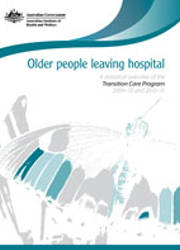Summary
The Transition Care Program (TCP) provides short‑term care to older people leaving hospital who are assessed as eligible for at least low‑level residential aged care. It aims to improve recipients' independence and functioning and delay entry into residential aged care. TCP can be delivered in the community (at home) or in a more home‑like residential setting.
This report presents statistics about TCP in 2010-11, with some information about the program in 2009-10 and over its first 6 years.
TCP has assisted nearly 52,000 people, including more than 18,000 in 2010-11
From the start of the TCP until 30 June 2011 there were just over 60,500 episodes of care provided to a total of 51,882 people.
During 2010-11, there were 18,084 individual TCP recipients receiving at least part of 20,277 episodes of care. This was an increase from 15,018 individuals and 16,736 episodes in 2009-10. In both these years, the median age was 82 and around 2 in 3 TCP episode recipients were women.
Functional capacity improved for most people completing TCP treatment
In 2010-11, 56% of recipients improved in functioning during their TCP episode. In the 73% of episodes where recipients completed planned care (that is, excluding those who moved to another service outlet, returned to hospital or died), three‑quarters (75%) had improved functional capacity. A further 17% maintained their existing level of function during their TCP episode, while functional capacity deteriorated for just 8%.
About half of the care recipients returned to live in the community
In 2010-11, more than 8,400 (49%) care recipients returned to the community after their TCP care episode. Just under 1 in 5 entered residential care (19%), while 23% returned to hospital and 2% died.
TCP has consistently achieved its aims since its introduction in 2005-06
Over the six years since its introduction, more than 60% of recipients left the program with an improved level of functioning.
Since 2005-06, the proportion of care recipients who finally returned to the community has ranged between 48% and 56% (54% overall).
Of those with consecutive episodes of care, outcomes were best for those clients who transferred directly from one service outlet to another, with 72% of these people eventually returning to the community.



